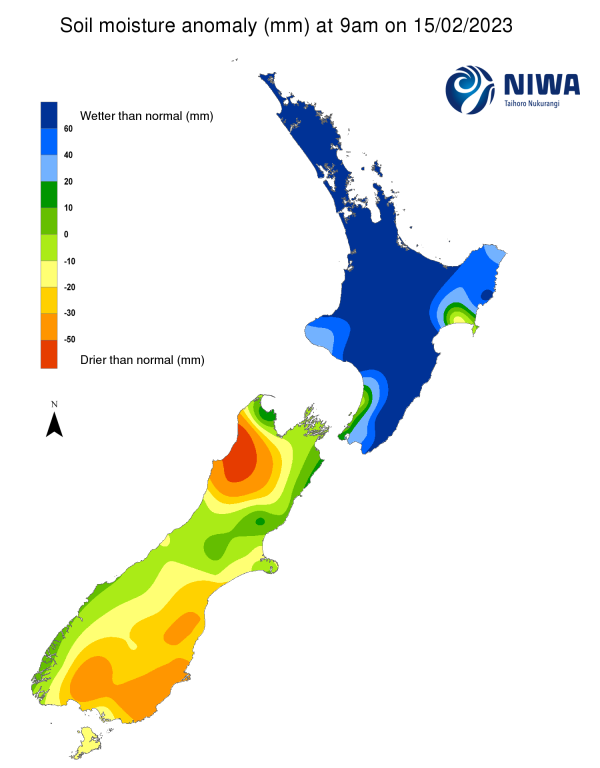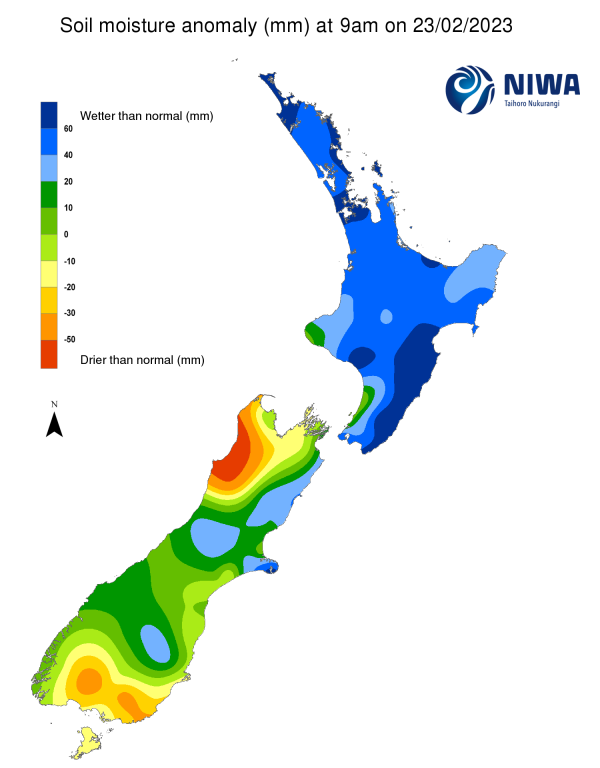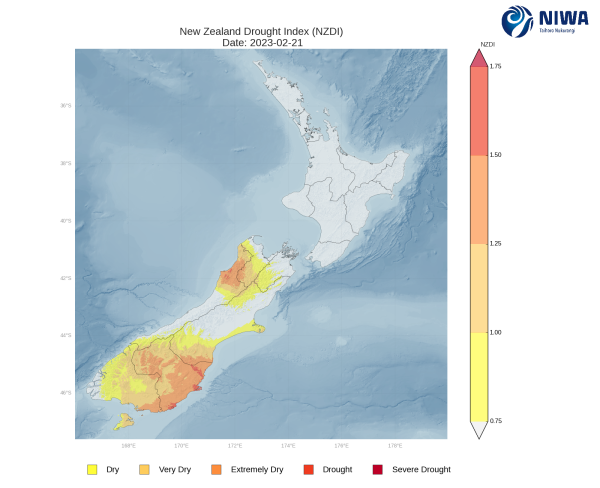A weekly update describing soil moisture patterns across the country to show where dry to extremely dry conditions are occurring or imminent. Regions experiencing significant soil moisture deficits are deemed "hotspots". Persistent hotspot regions have the potential to develop into drought.
Facts: soil moisture
In the North Island, most areas saw light rainfall during the past week, generally 25 mm or less. Northern and western areas in particular saw meagre rainfall of generally less than 10 mm. Pockets of heavier rainfall greater than 30 mm were observed near the Coromandel, northern Hawke's Bay, interior Manawatū-Whanganui, and northern Wellington. This resulted in a majority of the North Island seeing moderate soil moisture decreases in the past week, although soils generally remain much wetter than normal for the time of year. The driest soils across the North Island, when compared to normal for this time of the year, are found along the Kapiti Coast and western Taranaki, while the wettest soils for this time of the year are found in parts of Northland, Auckland, and the lower east coast.
No hotspots are currently located in the North Island.
In the South Island, rainfall amounts of generally 50-100 mm were observed in the lower half of the West Coast during the past week, with isolated higher amounts. Significant rainfall of 30-60 mm also occurred in much of Canterbury and Otago. Lower amounts of 25 mm or less were observed in the top of the South Island along with much of Southland. This resulted in substantial soil moisture increases across Canterbury, Otago, and the lower West Coast, while some decreases occurred in Nelson and Tasman. The driest soils in the South Island, when compared to normal for this time of the year, are located in northern Buller District, while the wettest soils for this time of the year are found in Banks Peninsula.
A majority of the South Island's previous hotspots dissipated in the past week due to the recent rainfall, although this change may only be temporary. Small hotspots still exist in parts of Southland, however. As of 21 February, the New Zealand Drought Index (NZDI) map below shows that dry to extremely dry conditions are currently located in large portions of the northwestern and lower South Island, along with Banks Peninsula and Stewart Island. In addition, portions of eastern Otago are experiencing meteorological drought.
Outlook and soil moisture
In the North Island, areas of heavy rain are expected to affect regions such as Auckland, northern Waikato, the Coromandel Peninsula, Gisborne, and Hawke's Bay through Saturday morning (25 February). From Sunday (26 February), mostly dry weather is likely across the North Island for several days as high pressure settles over the region, although Monday (27 February) could feature moderate rain and thunderstorms in the upper and eastern North Island. Weekly rainfall totals of 50-100 mm (with isolated higher amounts) may occur in Auckland, northern Waikato, the Coromandel Peninsula, Gisborne, and Hawke's Bay, with lesser amounts in the Central Plateau and lower east coast. Rainfall totals may be substantially lower in Northland, Taranaki, and Manawatū-Whanganui, with weekly totals of 20 mm or less.
Due to the expected rainfall in the next week, additional soil moisture increases are likely to occur in the aforementioned heavy rainfall areas, but some soil moisture decreases may occur in Northland, Taranaki, and Manawatū-Whanganui.
In the South Island, light to moderate rain will occur along the northeastern coast into Sunday (26 February), with mostly dry weather elsewhere. High pressure will then bring generally dry weather through most of next week until some rain arrives in the West Coast around Wednesday (1 March). Weekly rainfall totals could reach or exceed 100 mm in the lower West Coast, with 25-50 mm possible in eastern Marlborough and northern Canterbury. However, much lighter amounts are expected elsewhere across the South Island, with weekly totals generally 15 mm or less.
Due to the expected rainfall in the next week, soil moisture levels will likely begin to decrease again in Nelson, Tasman, the upper West Coast, southern Canterbury, Otago, and Southland, while some increases may occur in northern Canterbury and the lower West Coast. Some previous hotspots from southern Canterbury to Southland may begin to re-form in the next week. In addition, a new hotspot may form near Nelson.
For more information on the potential for dryness in the weeks to come, please check out the drought forecasting tool, a collaboration between NIWA and the Ministry for Primary Industries.
Background
Hotspot Watch: a weekly advisory service for New Zealand media. It provides soil moisture and precipitation measurements around the country to help assess whether extremely dry conditions are imminent.
Soil moisture deficit: the amount of water needed to bring the soil moisture content back to field capacity, which is the maximum amount of water the soil can hold.
Soil moisture anomaly: the difference between the historical normal soil moisture deficit (or surplus) for a given time of year and actual soil moisture deficits.
Definitions: "Extremely" and "severely" dry soils are based on a combination of the current soil moisture status and the difference from normal soil moisture (see soil moisture maps at https://www.niwa.co.nz/climate/nz-drought-monitor/droughtindicatormaps)
Hotspot: A hotspot is declared if soils are "severely drier than normal" which occurs when Soil Moisture Deficit (SMD) is less than -110 mm AND the Soil Moisture Anomaly is less than -20 mm.
Pictured above: Soil Moisture Anomaly Maps, relative to this time of year. The maps show soil moisture anomalies over the past two weeks.
As of 21 February, the New Zealand Drought Index (NZDI) map below shows that dry to extremely dry conditions are currently located in large portions of the northwestern and lower South Island, along with Banks Peninsula and Stewart Island. In addition, portions of eastern Otago are experiencing meteorological drought. Please note: some hotspots in the text above may not correspond with the NZDI map. This difference exists because the NZDI uses additional dryness indices, including one which integrates the rainfall deficit over the past 60 days. Changes are therefore slower to appear in the NZDI compared to soil moisture anomaly maps that are instantaneously updated.




